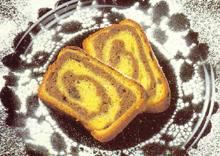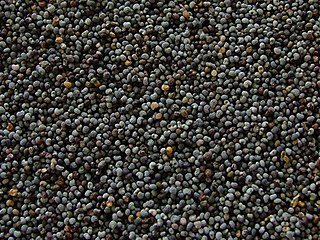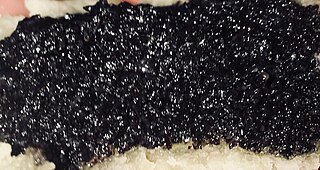
Dessert is a course that concludes a meal. The course consists of sweet foods, such as cake, biscuit, ice cream and possibly a beverage such as dessert wine and liqueur. Some cultures sweeten foods that are more commonly savory to create desserts. In some parts of the world there is no tradition of a dessert course to conclude a meal.

Hungarian or Magyar cuisine is the cuisine characteristic of the nation of Hungary, and its primary ethnic group, the Magyars. Hungarian cuisine has been described as being the spiciest cuisine in Europe. This can largely be attributed to the use of their piquant native spice, Hungarian paprika, in many of their dishes. A mild version of the spice, Hungarian sweet paprika, is commonly used as an alternative. Traditional Hungarian dishes are primarily based on meats, seasonal vegetables, fruits, bread, and dairy products.

Challah is a special bread of Ashkenazi Jewish origin, usually braided and typically eaten on ceremonial occasions such as Shabbat and major Jewish holidays. Ritually acceptable challah is made of dough from which a small portion has been set aside as an offering. Challah may also refer to the dough offering. The word is biblical in origin, meaning "loaf". Similar braided breads such as kalach and vánočka are found across Central and Eastern Europe.

Kugel is a baked casserole, most commonly made from lokshen or potato. It is a traditional Ashkenazi Jewish dish, often served on Shabbos and Jewish holidays. American Jews also serve it for Thanksgiving dinner.

Jewish cuisine refers to the worldwide cooking traditions of the Jewish people. During its evolution over the course of many centuries, it has been shaped by Jewish dietary laws (kashrut), Jewish festivals and holidays, and traditions centred around Shabbat. Jewish cuisine is influenced by the economics, agriculture, and culinary traditions of the many countries where Jewish communities have settled and varies widely throughout the entire world.

A hamantash is an Ashkenazi Jewish triangular filled-pocket pastry associated with the Jewish holiday of Purim. The name refers to Haman, the villain in the Purim story. In Hebrew, hamantashen are also known as אוזני המן, meaning "Haman's ears". "Haman's ears" also refers to a Sephardic Purim pastry, "Orejas de Haman", thought to originate in Spain and Italy, that is made by frying twisted or rolled strips of dough.

Potato bread is a form of bread in which potato flour or potato replaces a portion of the regular wheat flour. It is cooked in a variety of ways, including baking it on a hot griddle or pan, or in an oven. It may be leavened or unleavened, and may have a variety of other ingredients baked into it. The ratio of potato to wheat flour varies significantly from recipe to recipe, with some recipes having a majority of potato, and others having a majority of wheat flour. Some recipes call for mashed potatoes, with others calling for dehydrated potato flakes. It is available as a commercial product in many countries, with similar variations in ingredients, cooking methods, and other variables.

Mandelbrot, with a number of variant spellings, and called mandel bread or kamish in English-speaking countries and kamishbrot in Ukraine, is a type of cookie found in Ashkenazi Jewish cuisine and popular amongst Eastern European Jews. The Yiddish word mandlbroyt literally means almond bread, a reference to its common ingredient of almonds. It is typically formed by baking a loaf which is then cut into small slabs and twice-baked in order to form a crunchy exterior. The cookies were popular in Eastern Europe among rabbis, merchants and other itinerant Jews as a staple dessert that kept well.

A nut roll is a pastry consisting of a sweet yeast dough that is rolled out very thin, spread with a nut paste made from ground nuts and a sweetener like honey, then rolled up into a log shape. This 'log' is either left long and straight or is often bent into a horseshoe shape, egg washed, baked, and then sliced crosswise. Nut rolls resemble a jelly roll but usually with more layers of dough and filling, and resemble strudels but with fewer and less delicate dough layers. Fillings commonly have as their main ingredient ground walnuts or poppy seeds.

Poppy seed is an oilseed obtained from the opium poppy. The tiny, kidney-shaped seeds have been harvested from dried seed pods by various civilizations for thousands of years. It is still widely used in many countries, especially in Central Europe and South Asia, where it is legally grown and sold in shops. The seeds are used whole or ground into meal as an ingredient in many foods – especially in pastry and bread – and they are pressed to yield poppyseed oil.

Israeli cuisine primarily comprises dishes brought from the Jewish diaspora, and has more recently been defined by the development of a notable fusion cuisine characterized by the mixing of Jewish cuisine and Arab cuisine. It also blends together the culinary traditions of the various diaspora groups, namely those of Middle Eastern Jews with roots in Southwest Asia and North Africa, Sephardi Jews from Iberia, and Ashkenazi Jews from Central and Eastern Europe.

The poppy seed roll is a pastry consisting of a roll of sweet yeast bread with a dense, rich, bittersweet filling of poppy seed. An alternative filling is a paste of minced walnuts, or minced chestnuts.

Mizrahi Jewish cuisine is an assortment of cooking traditions that developed among the Jews of the Middle East, North Africa, Asia, and Arab countries. Mizrahi Jews have also been known as Oriental Jews.

A babka is a sweet braided bread which originated in the Jewish communities of Poland and Ukraine. It is popular in Israel and in the Jewish diaspora. It is prepared with a yeast-leavened dough that is rolled out and spread with a filling such as chocolate, cinnamon, fruit, or cheese, then rolled up and braided before baking.

Ashkenazi Jewish cuisine is an assortment of cooking traditions that was developed by the Ashkenazi Jews of Central, Eastern and Northern Europe, and their descendants, particularly in the United States and other Western countries.

Malawach or Melawwaḥ,, is a flatbread that is traditional in the Yemeni cuisine. It was brought to Israel by Yemenite Jews. Malawach resembles a thick pancake but consists of thin layers of puff pastry brushed with oil or fat and cooked flat in a frying pan. It is traditionally served with hard-boiled eggs, zhug, and a crushed or grated tomato dip. Sometimes it is served with honey.
Impade is a cookie of Sephardi Jewish origin that is most commonly found among members of the Venetian Jewish community and their descendants, and is traditionally prepared at Purim, but is also prepared year round.
Mohn kichel, also known as mon kichel, or poppy seed kichel, is an Ashkenazi Jewish cookie made with poppy seeds. Mohn kichel were popular among the inhabitants of the shtetl, as they were more economical to make than other Jewish cookies such as rugelach. Despite its similar name, mohn kichel bears little resemblance to the light, airy and crisp kichel to whom it is similarly baked, as mohn kichel is generally thin, crisp, and rectangular-shaped.

Mohn bar, also known as mon bar, or poppy seed bar, is an Ashkenazi Jewish baked good consisting of a shortcrust pastry base with a sweet mohn filling, and a streusel/crumb topping. It may be commonly found at kosher bakeries and Jewish delis across the United States.


















